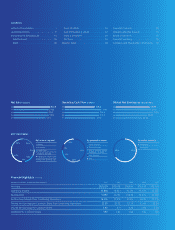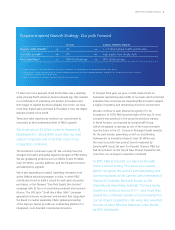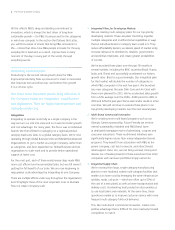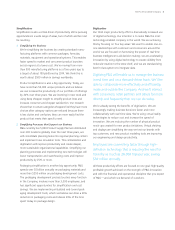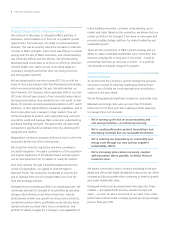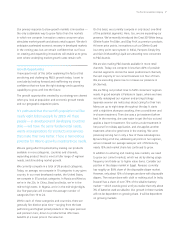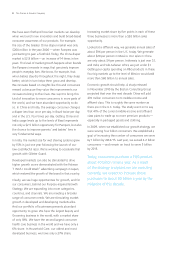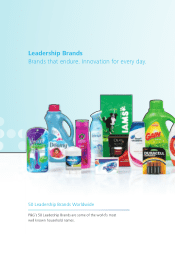Proctor and Gamble 2011 Annual Report Download - page 6
Download and view the complete annual report
Please find page 6 of the 2011 Proctor and Gamble annual report below. You can navigate through the pages in the report by either clicking on the pages listed below, or by using the keyword search tool below to find specific information within the annual report.
All this reflects P&G’s deep and abiding commitment to
innovation, which is always the best driver of long-term
sustainable growth—for P&G’s business and for the categories
in which we compete. In the section that follows this Letter,
you will find a series of stories that bring P&G innovation to
life—stories that show how P&G people innovate for the way
everyday life is lived and, as a result, improve lives in every
moment of the day, in every part of the world, through
everything we do.
Productivity Fuels Innovation
Productivity is the second critical growth driver for P&G.
Improved productivity frees up resources to invest in innovation
that improves lives and drives top- and bottom-line growth.
It is a virtuous cycle.
Our three most important productivity initiatives in
the Company today are integration, simplification
and digitization. They are highly interdependent and
mutually reinforcing.
Integration
Integrating to operate more fully as a single company is the
way we turn our size into scale and our scale into faster growth
and cost advantage. For many years, the focus was on individual
brands. We then shifted to managing on a regional product
category basis and, later, to a global category basis. We’re now
operating through Global Business Units and Market Development
Organizations to go to market as a single Company, rather than
as categories, and have expanded our Global Business Services
organization to scale work and to provide better operational
support at lower cost.
For the most part, each of these evolutionary steps made P&G
more cost efficient and incrementally faster, but we still weren’t
getting the full benefit of our scale. We are now beginning to
reap greater scale advantages by integrating as one Company.
There are multiple efforts under way throughout the organization,
but I’ll highlight three of the most important ones to illustrate
how we create Company scale.
1. Integrated Plans for Developing Markets
We are creating multi-category plans for our top-priority
developing markets. These are plans that bring together
multiple categories and multifunctional capabilities in ways
that an individual brand or category team could not. They
reduce affordability barriers, accelerate speed of market entry,
increase relevance to distributors, retailers, governments
and potential employees, and create greater probabilities
of success.
We’ve launched these plans over the past months in
several markets, including the BRIC countries (Brazil, Russia,
India, and China) and successfully accelerated our historic
growth rates. Brazil is a good example. Our integrated plan
for that market will double the number of categories in
which P&G competes in the next few years. We launched
two new categories this year (Skin Care and Air Care) with
three more planned for . We’ve accelerated sales growth
from a % average over the – period to % in
and % this past year. We’ve seen similar results in other
countries. We will continue to execute these plans in our
top-priority developing markets over the next several years.
2. Multi-Brand Commercial Innovation
We’re creating more multi-brand programs such as our
Olympic Games sponsorship, Future Friendly (an environ-
mental sustainability initiative) and P&G Brand Saver
(a dedicated newspaper insert of advertising, coupons and
consumer education). These multi-brand initiatives earn
significantly higher returns than many independent brand
programs. They benefit from association with P&G as the
parent company, cost less to execute, and attract broad
retail support. Here, too, we can bring a broad, strong and
diverse mix of leading brands to these executions that other
companies with narrower portfolios simply cannot do.
3. Integrated Supply Chain
We’re moving from large, single-category manufacturing
plants to more localized, scaled multi-category facilities that
enable us to lower cost by leveraging the same infrastructure
(utilities, roads, rail spurs—which are often up to % of
the cost of a new plant), as well as lower transportation and
delivery costs. Accelerating local production also enables us
to use local talent and materials. At the same time, these
operations enable us to improve customer service with more
frequent multi-category full-truck deliveries.
This, like multi-brand commercial innovation, creates com-
petitive advantage that is difficult for more narrowly focused
competitors to match.
4The Procter & Gamble Company


